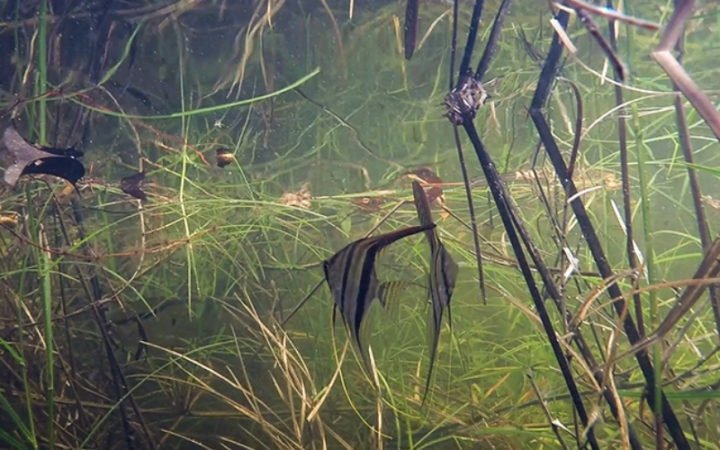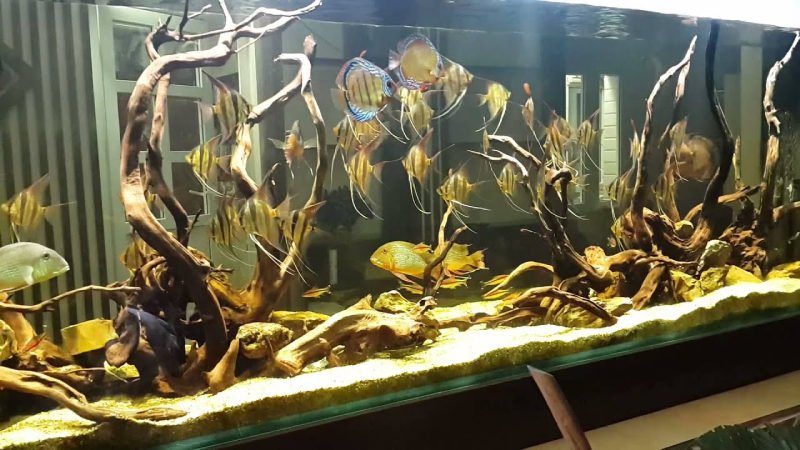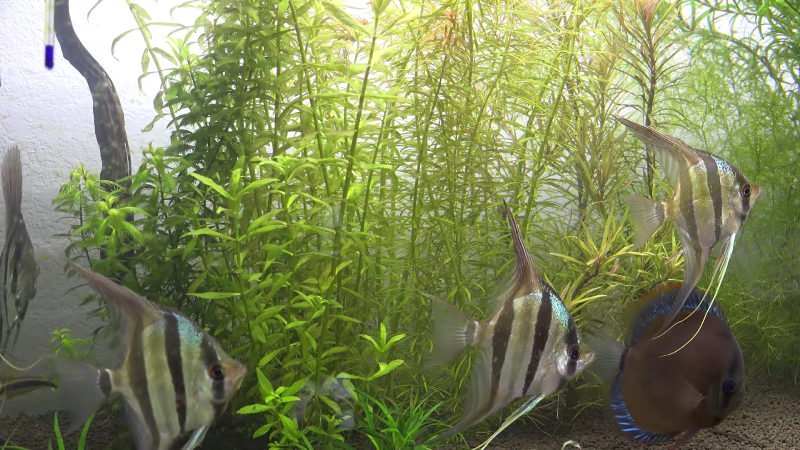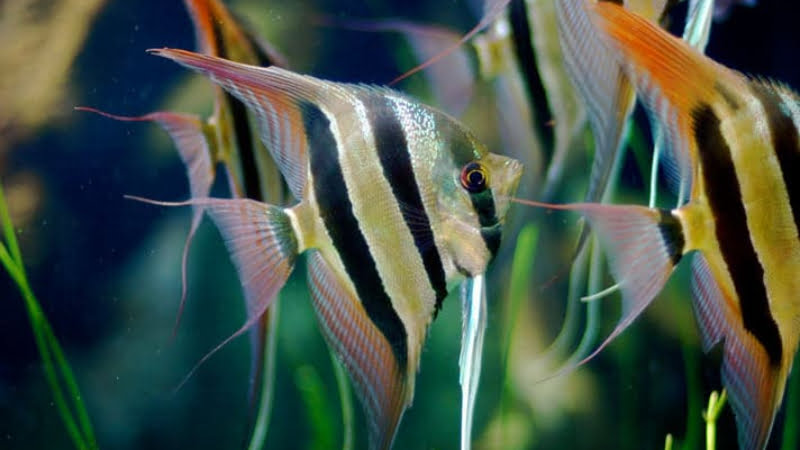The Pterophyllum genus (angelfish) is a widespread genus in South America, resulting in confusion when distinguishing between many species within the genus in the wild. Currently, there are three different classified kinds of angelfish: Pterophyllum scalare, Pterophyllum altum, and Pterophyllum leopoldi.
Pterophyllum Altum or Altum angelfish is the largest representative of the Pterophyllum genus. In this article, we will find out all about the Altum angelfish. That includes where it inhabits, how to keep it, feed it, breed it, etc.
Related Articles
- Coral Beauty Angelfish Best Profile: Habitat, Size, Behavior, Lifespan, Diet, Breeding & More
- 2 Characteristics About Black Angelfish That You May Not Know
- Where To Buy Altum Angelfish? 3 Big Risks You Have To Face
- Koran Angelfish: All About Full Size, Reef Safe & More
Altum Angelfish: Quick Overview
| Scientific Name | Pterophyllum altum |
| Family | Cichlidae |
| Common Name | altum angelfish, deep angelfish, Orinoco angelfish |
| Ease of keeping | Difficult |
| Lifespan | 5 years and more |
| Tank size | at least 55 gallon |
| Temperament | Peaceful |
| Tank type | Community of large fishes |
| Diet | Omnivorous |
| Temperature | 82 to 90°F (28 to 32°C) |
| pH | 4.8-6.2 |
| Water hardness | 0-5°H |
| Size | height (from the tip of dorsal to the tip of anal fin) 38-40cm (15 in) |
Altum Angelfish In Wild

By 1903, Pellegrin described a new angelfish species, Pterophyllum altum. There are several places in South America where they are found, particularly those along the Amazon River Basin in the upper drainage of Negro River and those along the Orinoco River Basin in tributaries of the upper Orinoco River (the InInírida Rida and Atabapo rivers) to Puerto Ayacucho.
These fish are also known by the names Orinoco Angelfish, Altum Angelfish, and Deep Angelfish.
In the wild, these fish inhabit river watersheds and flood plains with moderate water flow, submerged trees and roots, and underwater vegetation. This kind of fish is most commonly found in very soft, well-oxygenated waters. These omnivores eat small fish and invertebrates as well as other food particles in the water.
Description
As I have already mentioned above, Altum angelfish is the largest representation among the three Pterophyllum species.
These fish are very long and can have dorsal and anal fins sweep up to 40 cm. The dorsal and anal fins are both pearl gray. The abdominal fin is also very long and filamentous in the first rays. They have a disk-shaped body and are rather flattened from the sides and sharpened snout.
The basic colors of the body range from greenish-gray to olive drab with silvery glitter, while the back has a brownish-olive tint. The body has four main lateral stripes. The color of the fish changes depending on its mood and behavior, and it can be mostly black, black-brown, or gray. The first stripe crosses the fish’s eye. The second is from the short dorsal rays to t the beginning of the anal fin. The third runs from the top of the dorsal to the anal fin apex. And the fourth runs from the beginning of the caudal fin.
Difficulties In Keeping
In the world of tropical fish, angelfish are considered to be among the most popular, and beginning aquarists will look to get started with them. The Altum Angelfish, however, is a fish that is extremely challenging to maintain and is not the best choice for people who are just starting out. The species of the family have a high risk of holes in the head disease, have difficulties dealing with nitrates, and are more prone to stress-related diseases as well. Furthermore, they are also very sensitive to the condition of the water, need very soft and acidic water, and can be quite difficult to feed.
Lifespan
For the altum angelfish living in an aquarium tank, their lifespan varies from 5 to 8 years. The females usually live about 6-12 months longer than their male counterparts. In this respect, the tank water temperature plays a crucial role. The higher the temperature, the faster the fish’s metabolic processes are, which results in decreasing lifespan correspondingly.
Tank Size & Setup

For a single fish, a 55-gallon aquarium is sufficient, but a larger tank is needed if there are going to be more fish. Water movement as well as the need for a very strong and efficient filtration is also necessary for fish. Considering that they come from a natural environment with well-oxygenated and soft water, it is recommended to use peat-filtered water.
Altum angels’ tanks must be equipped with plant roots and rock formations for them to hide in.
As for the substratum, there is no specific specification on it. This means that any substratum will be fine to use since the Altum angels are mid-level dwellers, mainly hiding and vegetation.
The filtration system in the Altum angelfish tank is designed mainly for the efficient filtration of the visible waste, and the chemical filtration is mainly for controlling the chemical contaminants, such as nitrates.
Additionally, a lighting system should be installed on the roof of the aquarium in order to provide a toned downlight.
Water Parameters And Temperature
To successfully maintain an altum angelfish, high quality water in the tank is essential. The water in their natural habitats is very soft. They are kept in a tank with water of middle hardness because it is easier to maintain their basic hydrochemical parameters in this case due to their small volume.
You should follow these parameters for the tank water:
- Temperature: 82 to 90°f (28 to 32°c)
- pH: 4.8-6.2.
- Hardness: 0-5°H.
Atlum Angels require a strict water change schedule that includes at least 25% every week. Make sure to test any water that is going back into the tank, as the Angel is very sensitive to water fluctuations. If you perform water changes, make sure that you vacuum the substrate thoroughly after each change. Whenever the tank is cleaned, and water is changed, take great care so as not to cause unnecessary or excessive stress to the fish, as they are prone to stress-related diseases.
Social Behavior

The Altum angelfish are generally considered a ‘community fish” but as the fish grow older, they may become a bit territorial. The Altum angelfish are more peaceful than other angelfish species. Because they belong to the cichlid family, smaller fish may not be compatible with them. After maturing, males and females will pair off and develop a strong nuclear family and then defend a territory for breeding. There is one nice thing about the Altum Angelfish is that they do not burrow or disturb the plants in the tank.
Tank Mates
Fish that occupy the middle and bottom water layers in a community tank can be paired with Altum angelfish. Middle-sized fish will do well in the mid-water layer. Thus the following tank dwellers can be good tank mates for altum: black neon tetra, neon tetra, cockatoo cichlid, ram cichlid, bloodfin tetra, corydoras julii, emperor tetra, rummy nose tetra, flame tetra, panda cory, pygmy cory.
Tetra and Corydoras species mentioned above are all schooling fishes, so you should keep them together in a tank with at least ten species. Each species must pass a 4-week health test. For bottom-dwelling fishes, the requirement is the same.
Altum should not be kept with small fish, like oto catfish or bristlenose pleco juveniles. Although these algae-eating creatures are rather welcome in aquariums, their small size sooner or later causes them to be treated as the prey of altum.
Feeding
Generally, Altum Angelfish will eat a wide variety of living, fresh, or flake foods, as they are omnivorous fish. If you want to maintain a balanced diet for your fish, you have to give them flakes or pellets of high quality every day. Feed brine shrimp (living or frozen) or blood worms for a treat. Spinach and lettuce are also great treats. You will have to feed mosquito larvae very sparingly if you don’t want them overeaten. Overeating can result in the buildup of fats in the body, which results in inactivity and could even result in death.
Breeding
Altum angelfish have been caught from the wild and introduced into the aquarium trade business for years. It was not clear how to get the fish to breed in captivity. It’s just been a while since they’ve been bred in captivity.
It is recommended to breed the Altum angelfish with Scalare as they are closely related to one another, and it is very easy to breed these two angelfish. The resulting hybrid fish species is known as the Orinoco Altum fish.
To breed these fish, they are first paired together. When it comes to pairing them up, you need to place a couple of Altum angels or a group of them together and then wait until they are paired up with one another.
After you have paired them up, choose a suitable place where they can lay their eggs. The water should be clean and free of any debris. It is extremely important that the water should be clean in order for them to initiate spawning. Eggs are laid on immersed roots or branches of plants in the water.
They are then fertilized by the male. But there’s another issue here. Eggs can be eaten by their parents. When not eaten, the eggs will hatch within a few days. After hatching, you should remove the larvae from the tank if you wish to raise them.
Video About How To Keep Altum Angelfish
FAQs
What is the difference between Altum and Scalare angelfish?
Physiologically, P. altum is different from P. scalare in a variety of ways, the most distinctive one being the higher count of soft rays on the dorsal and anal fins. In addition to its long dorsal and anal fins, the vertical form of the fish, and its keenly concave forehead area, it has an unmistakably regal appearance.
Are Altum angelfish hard to keep?
Freshwater angelfish are very difficult to take care of, and they require more specialized, optimized water conditions to thrive. Also, they require more special feeding requirements, which are difficult to satisfy. So if you are a beginner, I don’t recommend you keep them.
How to define Altum angelfish’s gender?
Only during the fish’s spawning period can you define the fish’s gender. All secondary characteristics do not provide a certain indicator of fish gender if you don’t identify the gender at that time.
Male species tend to be a bit larger and have a taller body and a sharp forehead than female species. They are also more contrast-colored. Nevertheless, all of these traits are quite relative and strongly depend on the tank’s conditions.

Annette M. Chaney is an experienced marine biologist with over 20 years of experience as an aquarist and fishkeeper. She started her first aquarium at a young age, filling it with frogs and goldfish obtained from the ten-cent pet store.
Annette grew up caring for and breeding African Cichlids, which led to a hobby in high school that doubled as a profitable means. Attending Reed College gave her time to solidify herself as an accomplished aquarium caretaker with an eye for sales. After that, from 2009 – 2013, she studied at Roger Williams University – one of the most prestigious universities for Aquaculture and Aquarium in USA. She is the founder of AquariumCircle since 2010.
